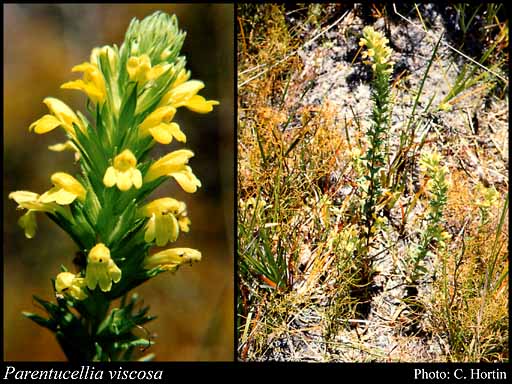This name is not current. Find out more information on related names.
- Reference
- Parl., Fl.Ital. 6:482-483 (1885)
- Conservation Code
- Not threatened
- Naturalised Status
- Alien to Western Australia
- Name Status
- Not Current
Erect, viscid annual or biennial (rarely), herb, (0.05-)0.1-0.7 m high. Fl. yellow, Aug to Dec or Feb. Sandy, clay or lateritic soils. Swampy areas, granite outcrops.







Management Notes (for the Swan NRM Region)
Alternative Names. Yellow Bartsia, Yellow Glandweed, Sticky Parentucellia.
General Biology. Growth form. Herb. Life form. Annual. Reproduction. Seed. Dispersal. Wind, water machinery, clothing. Seedbank persistence. At least one year.
Notes. Hemiparasitic on the roots of other plants, but can germinate and grow without hosts. Able to colonise a wide range of hosts. Produces numerous small seeds. Seed heads adhere to clothing.
Additional information. Origin. Mediterranean region, western Europe. Similar exotic species. Bartsia trixago, Parentucellia latifolia.
Suggested method of management and control. Remove isolated plants manually before flowering. Try spot spraying with glyphosate 0.5% before flowering. Read the manufacturers' labels and material safety data sheets before using herbicides. For further information consult the Australian Pesticides and Veterinary Medicines Authority to determine the status of permits for your situation or state.
Management Calendar
| Calendar Type | Jan | Feb | Mar | Apr | May | Jun | Jul | Aug | Sep | Oct | Nov | Dec | Comments |
|---|---|---|---|---|---|---|---|---|---|---|---|---|---|
| Germination | Y | Y | Y | Y | Y | Y | Y | ||||||
| Active Growth | Y | Y | Y | Y | Y | Y | Y | Y | |||||
| Flowering | Y | Y | Y | Y | Y | Y | |||||||
| Fruiting | U | U | U | U | |||||||||
| Manual Removal | Y | Y | O | O | O | ||||||||
| Herbicide Treatment | Y | Y | O | O |
Legend: Y = Yes, regularly, O = Occasionally, U = Uncertain, referred by others but not confirmed.
References
- Brown, K. & Brooks, K. (2002) Bushland Weeds: A Practical Guide to their Management. Environmental Weeds Action Network, Greenwood.
- Brusati, E. & Corelli, T. (2003) California Invasive Plant Inventory Assessment Form: Parentucellia viscosa. California Invasive Plant Council URL: http://www.cal-ipc.org/ip/inventory/PAF/Parentucellia%20viscosa.pdf - Accessed May 2010.
- Emerzian, V.K. (2007) Radiant heater effects on Leontodon taraxacoides, Hypochaeris glabra, and Parentucellia viscosa in dunes and seasonal swales at Humboldt Bay National Wildlife Refuge. Humboldt State University, Natural Resources: Planning URL: http://humboldt-dspace.calstate.edu/xmlui/handle/2148/340?show=full - Accessed May 2010.
- Hussey, B.M.J., Keighery, G.J., Dodd, J., Lloyd, S.G. & Cousens, R.D. (2007) Western Weeds. A guide to the weeds of Western Australia. 2nd Edition. The Plant Protection Society of Western Australia, Victoria Park.
- Moore, C.B. & Moore, J.H. (2002) Herbiguide, the pesticide expert on a disk. Herbiguide, PO Box 44 Albany, Western Australia, 6330.
- Pate, J.S. & Bell, T.L. (2000) Host associations of the introduced annual root hemiparasitic Parentucellia viscosa in agricultural and bushland settings in Western Australia. Annals of Botany, 85: 203-213.